For B2B companies, the cost of securing each new customer can make or break your growth. But in today’s competitive landscape, acquisition costs are ballooning out of control. How can you slash your customer acquisition costs amid rapid growth? This comprehensive guide explores battle-tested tactics to optimize every dollar you spend chasing new customers. You’ll discover CAC benchmarks across industries, pinpoint areas for optimization, avoid critical mistakes, and implement proven strategies to sustainably lower costs. With examples, actionable tips, and real-world data, unlock the secrets to acquiring customers profitably at scale. Let’s get started and transform your sales and marketing ROI.
Understanding B2B Customer Acquisition Cost (CAC)
For any business leader, one of the most critical metrics to understand is your customer acquisition cost, or CAC. This measures how much you are spending to acquire each new customer. Optimizing your CAC is key to profitability and scalable growth.
In this section, we’ll cover everything you need to know about demystifying CAC for B2B companies. Let’s dive in!
What Exactly is CAC?
CAC refers to the total cost of acquiring a new customer. This includes all marketing, sales, and service expenses involved from initial outreach to closing the sale.
For example, say your sales team spent $5,000 last month on conferences, emails, cold calls, content offers, and sales reps to land 10 new customers. Your CAC would be $5,000 / 10 new customers = $500.
Bottom line: CAC shows you how much you are spending to grow your customer base. The lower the CAC, the more efficient your customer acquisition efforts are.
Calculating Your B2B CAC Step-By-Step
Figuring out your CAC takes just three easy steps:
Step 1) Add up all sales, marketing, and customer success costs over a defined period (typically monthly or quarterly). This includes salaries, ads, events, content offers, and any other expenses tied to acquisition.
Step 2) Count the number of new customers won in the same period. Be sure to only count brand new accounts here, not existing customer growth or expansions.
Step 3) Divide your total costs by the number of new customers to get your CAC.
Pro Tip: You can calculate CAC for specific campaigns too. Just total the costs tied to that campaign and divide by customers acquired through it.
CAC vs. CLV: What’s the Connection?
On its own, CAC doesn’t tell you much. You need to compare it to the customer lifetime value (CLV) to understand profitability.
CLV represents how much revenue a customer will generate over their entire relationship with you. This factors in repeat purchases, expansions, renewals, and more.
Ideally your CLV should be 3-4x higher than CAC. This means the long-term profits from customers far outweigh what you spent to acquire them.
If your CAC is higher than CLV, acquisition efforts are losing you money! Tweaking marketing and sales processes to lower CAC is crucial in this case.
For SaaS companies, a CAC payback period of 12-24 months is healthy. This means it takes 1-2 years to earn back what you spent on acquiring each customer through their ongoing revenue.
Hope this clears up the critical differences between CAC and CLV! Now let’s look at how to improve your CAC…
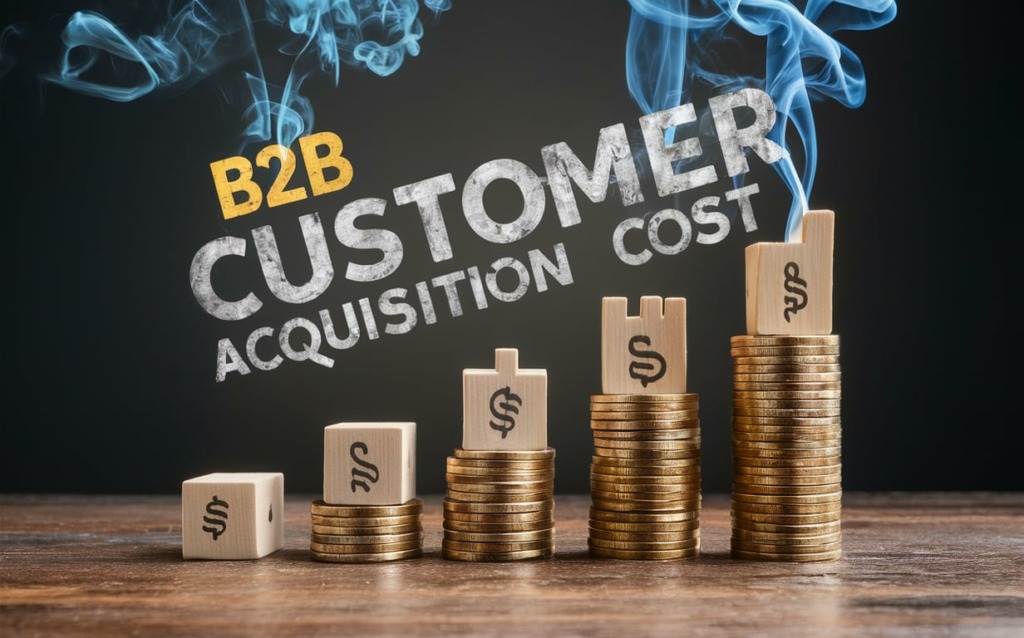
Average CAC Benchmarks for B2B Companies
Now that you know how to calculate customer acquisition cost (CAC), you’re probably wondering: How does my CAC stack up against others in my industry?
Benchmarking your CAC is crucial for assessing how efficient your sales and marketing machine is relative to competitors.
In this section, we’ll overview typical CAC ranges across common B2B verticals and what causes variance between businesses.
Typical B2B CAC Benchmarks by Industry
CAC varies widely between industries based on average deal sizes, sales cycles, and marketing tactics. Here are typical benchmarks for major sectors:
Software/SaaS: $200-$800
- Short sales cycles and relatively low ASPs facilitate low CACs.
IT Services: $900-$1,500
- Longer sales cycles and service bundles drive up costs.
Business Consulting: $1,000-$2,000
- Extensive relationship building and long sales processes increase CAC.
Healthcare: $300-$1,000
- Highly regulated industry requires customized, targeted marketing.
Manufacturing: $100-$600
- Smaller deals but less hand-holding required.
Financial Services: $800-$1,200
- Heavily compliance-focused, with long sales cycles.
Real Estate: $300-$800
- Agent commissions are high but marketing is primarily digital.
As you can see, the differences are significant. Software companies can acquire customers for a fraction of the cost of management consultants or IT services firms.
Key Factors Influencing B2B CAC
Several variables account for the CAC differences between industries:
- Deal size – Larger ASPs mean bigger commission costs.
- Sales cycle length – More touchpoints and longer nurturing drives up CAC.
- Marketing channels – In-person events are far costlier than digital.
- Touchpoints to close – Complex sales with multiple stakeholders have higher CACs.
- Customer longevity – The longer they stay, the more you can spend upfront to acquire.
- Product/market fit – If demand is high, CACs decline.
- Economies of scale – Mature companies can leverage brand authority to reduce CAC.
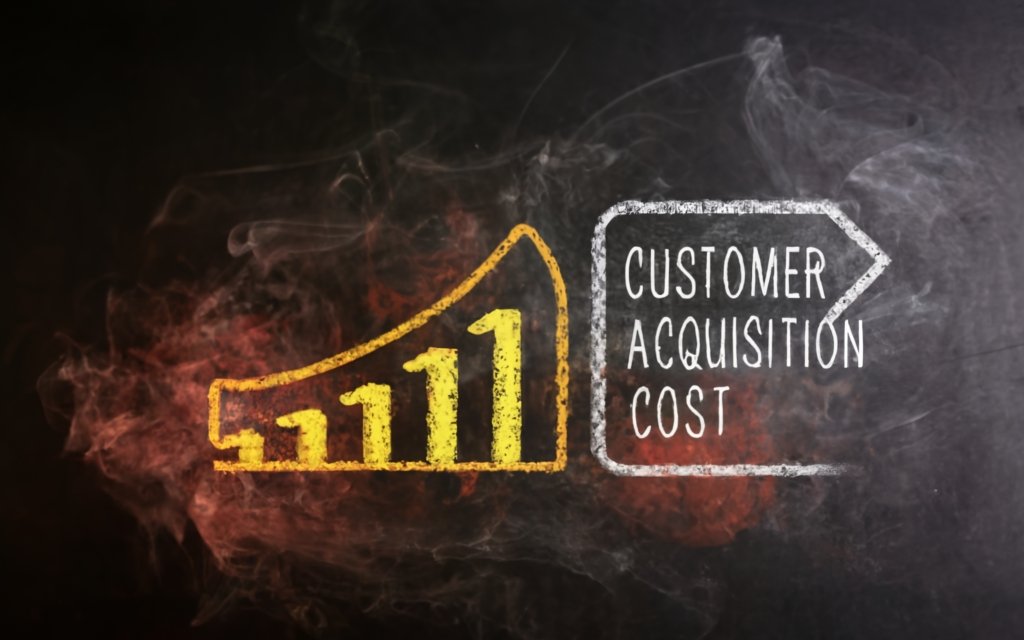
How to Improve Your B2B CAC
So you’ve calculated your customer acquisition cost. Maybe it’s higher than benchmarks for your industry. Perhaps it’s creeping up quarter over quarter. Either way, it’s time to dig into reducing your CAC.
The good news? There are proven tactics that can dramatically optimize your CAC when executed correctly.
In this section, we’ll cover actionable strategies for improving your B2B CAC across these key areas:
- Optimizing marketing channels
- Increasing conversion rates
- Personalizing prospect experiences
- Launching referral programs
- Choosing the right metrics to track
Let’s dive in and slash that CAC!
Optimize Marketing Channels
Not all marketing channels are created equal when it comes to CAC. Analyzing your channels on a cost-per-acquisition basis is critical.
Start by calculating CAC for each major channel: content, social, paid search, events, etc. Identify the lowest CAC channels with the highest return.
Next, shift more budget and resources towards those winners. Double down on what already works before expanding into new initiatives.
Conversely, high CAC channels may need to be optimized or culled completely. Limit spend on low-converting tactics.
Takeaways:
- Audit channel CAC regularly and reoptimize budget allocation.
- Don’t over-rely on outdated high-touch channels like events or print ads.
- Lean into scalable, low-CAC digital marketing. SEO delivers 4x higher conversion rates than paid search, for example.
Increase Conversion Rates
Higher conversion rates directly translate to lower CAC. But how exactly can you move the needle on conversion?
Start with your website. Use on-page user behavior analytics to identify friction points. Remove form fields, simplify messaging, and optimize user flows.
Next, analyze your funnel’s weak points. Find where prospects are dropping out and swiftly address those leaks.
Finally, leverage chatbots, live chat, and email nurturing to answer questions and guide prospects to conversion. The more hands-on, the better.
Bottom line? Conversion is about meticulously eliminating friction across the entire customer journey.
Personalize Prospect Experiences
Personalized, tailored outreach converts prospects faster thanks to relevance. But manual customization isn’t scalable.
Marketing automation tools can serve up dynamic, personalized messaging without added work. Send segmented emails, tailor landing pages, and more.
Sales reps should also take a targeted approach. Research prospects before calls and highlight relevant pain points or case studies.
With personalization, prospects feel understood and that your solution is a natural fit. CAC decreases as relevance increases.
Create Customer Referral Programs
Referrals from existing customers are up to 10x more effective than cold outreach. Their testimonials hold more weight with prospects.
Reward customers for referrals with discounts, premium features, or credits. Gamification keeps engagement high.
Promote referral programs prominently in your app, website, and post-purchase emails. The path to participation should be crystal clear.
Referral program pros:
- Lower CAC thanks to warm introductions
- Higher conversion rates from trusted referrers
- Lower marketing costs compared to cold outreach
Track Granular CAC Metrics
Mere CAC calculations only reveal so much. You need to dig deeper with metrics to pinpoint optimization opportunities.
Analyze CAC by channel, geo, sales rep, lead source, ad campaign, and other cuts. Look for trends and outliers.
Chart CAC movements over time, assessing seasonality. Set quarterly benchmarks to stay on track.
Attribution modeling also connects touchpoints to conversions, highlighting your most effective efforts.
Pro Tip: Marketing automation makes deep CAC analysis much easier. Dashboard views provide insights instantly.
B2B CAC is a complex beast but can be tamed. Stick with these proven approaches to slay acquisition costs and drive growth. What area will you optimize first?
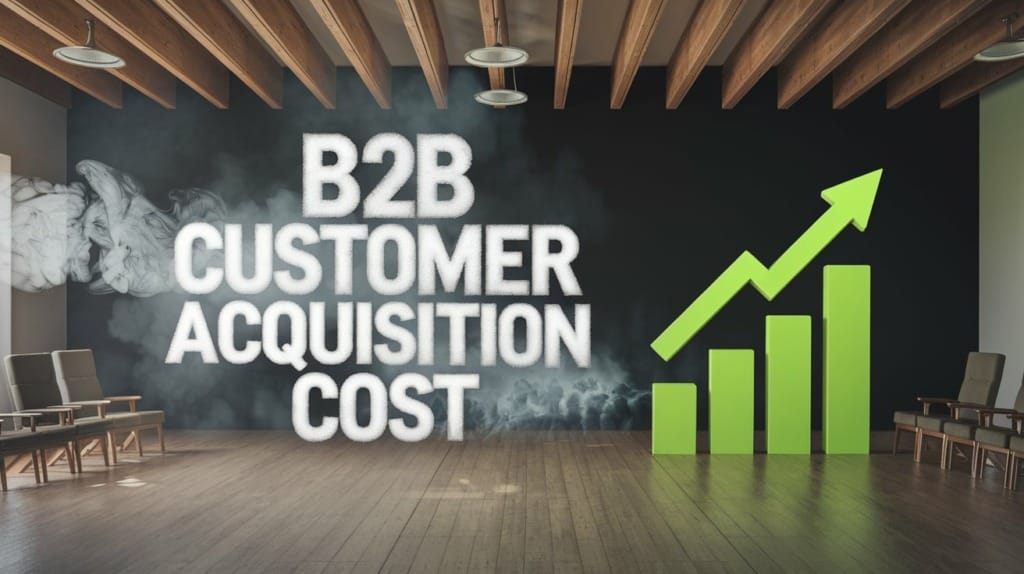
B2B CAC Mistakes to Avoid
Optimizing your customer acquisition cost (CAC) isn’t easy. There are plenty of pitfalls that can sabotage your efforts or lead you astray if you’re not careful.
In this section, we’ll overview four of the most common – and impactful – CAC mistakes made by B2B companies:
- Overspending without tracking ROI
- Not calculating LTV accurately
- Not segmenting your audience
- Ignoring retention and churn
Avoiding these missteps is crucial for efficient acquisition and growth. Let’s take a deeper look at each CAC mistake and how to prevent it.
Mistake #1: Overspending Without Tracking ROI
It’s tempting to continuously amp up spending to drive more leads and sales. But without diligently tracking the return on your investments, you can easily overspend.
Marketing and sales costs must be measured against the revenue being generated. At minimum, calculate the ROI of your major programs and campaigns.
Drill deeper by determining channel-by-channel CAC. Stop spending on low-return activities.
Tools like marketing attribution help you connect spending to pipeline and revenue generation. This enables you to double down on what works.
Set quarterly ROI targets and routinely assess performance. Continually optimizing ROI is vital for efficient CAC.
Mistake #2: Not Calculating LTV Accurately
We know the importance of comparing CAC to customer lifetime value (LTV). But adequately estimating LTV is tricky.
The biggest mistake? Using simple averages based on past customers. Their churn risks and repurchase patterns won’t mirror future customers.
Avoid this by:
- Factor in projections, trends, and predictive analytics into LTV
- Segmenting LTV by customer type, region, etc.
- Regularly updating LTV estimates as new data comes in
An accurate LTV gives you more confidence in acquisition investments. Take the time to calculate it thoroughly.
Mistake #3: Not Segmenting Your Audience
Prospects have diverse needs, challenges, and motivations. Marketing to them uniformly is doomed to fail.
But many B2Bs take a spray-and-pray approach, spreading budgets thinly across low-fidelity campaigns.
Audience segmentation is mandatory for lowering CAC. Zero in on high-value subsets with targeted messaging and offers.
Use data to group prospects based on engagement, attributes, behaviors, or firmographics. Then double down on the high-potential segments.
Segmentation allows personalized, scalable campaigns. CAC drops as relevancy increases. Don’t ignore this quick win.
Mistake #4: Ignoring Retention and Churn Rate
Customer retention directly impacts acquisition costs in multiple ways. First, higher retention means fewer resources required for replacement sales. Second, it maximizes the value extracted from each customer pre-churn.
However, many businesses focus obsessively on new customers without protecting their flank. They lack strategies to win back churned accounts or identify at-risk customers.
Regularly assess metrics like churn rate, NPS, and ACV expansion trends. Implement tailored retention initiatives:
- Loyalty programs
- Product adoption managers
- Marketing re-engagement
- Churn analysis
Reduce spend on acquisitions by doubling down on customer success.
Avoiding these universal CAC pitfalls separates the pros from the pack. With proper optimization, your B2B can acquire customers efficiently and drive scalable growth.
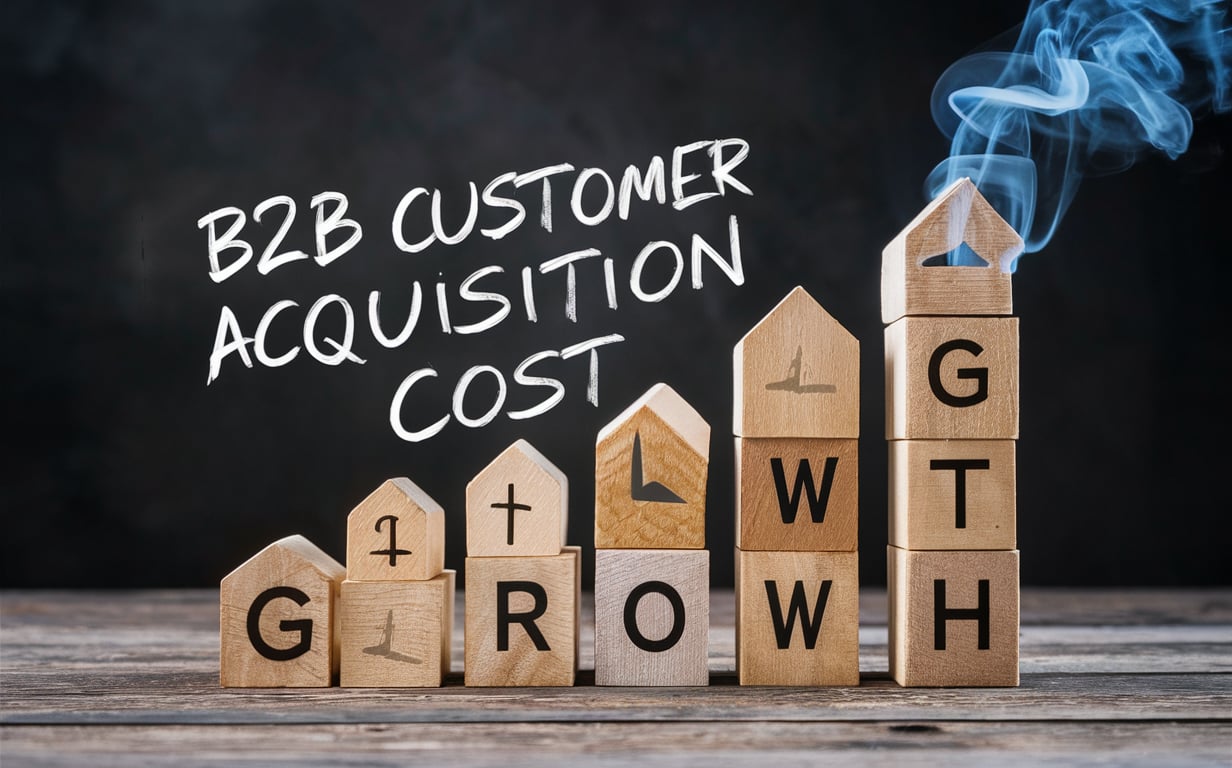
Tips for Keeping B2B CAC Low
After all this talk about customer acquisition cost (CAC), you’re probably eager to actually lower yours. We’ve got you covered with proven tips to minimize CAC.
In this section we’ll cover:
- Leveraging organic marketing
- Delighting existing customers
- Offering free trials and content
- FAQs about optimizing CAC
Let’s dive in!
Leverage Organic Marketing
Paid advertising delivers instant gratification but sustaining it long-term is expensive. Organic marketing, while slower to materialize, is extremely cost-efficient long-term.
SEO, in particular, is a must for lowering CAC. Optimized content generates targeted traffic for years with minimal upkeep costs.
Social media and PR offer similar lasting benefits. Position executives as thought leaders and nourish your community for the long-haul.
Organic and paid work best together, with paid amplifying core content. Take an always-on approach for maximum conversion while minimizing additional spend.
Double Down on Existing Customers
It costs 5-25x more to acquire new customers than retain existing ones. So optimizing retention also lowers your replacement CAC.
Go above and beyond with customer success:
- Proactively check in quarterly
- Anticipate needs before they churn
- Offer loyalty perks and discounts
- Solve issues quickly and thoroughly
Marketing should also nurture customers post-sale with surveys, education, events, and communication.
Turn happy customers into vocal advocates with referrals and word-of-mouth marketing. They become your most effective marketers.
Offer Free Trials and Content
Subscribers need to experience your product’s benefits for themselves before committing long-term.
Generous, no-strings-attached free trials convert significantly better than limited trials. Let customers fully explore the platform and see their own data populated.
Similarly, offer free tools, calculators, templates, and content launches to build trust and credibility.
The goal is to move prospects smoothly through the funnel by proving value upfront.
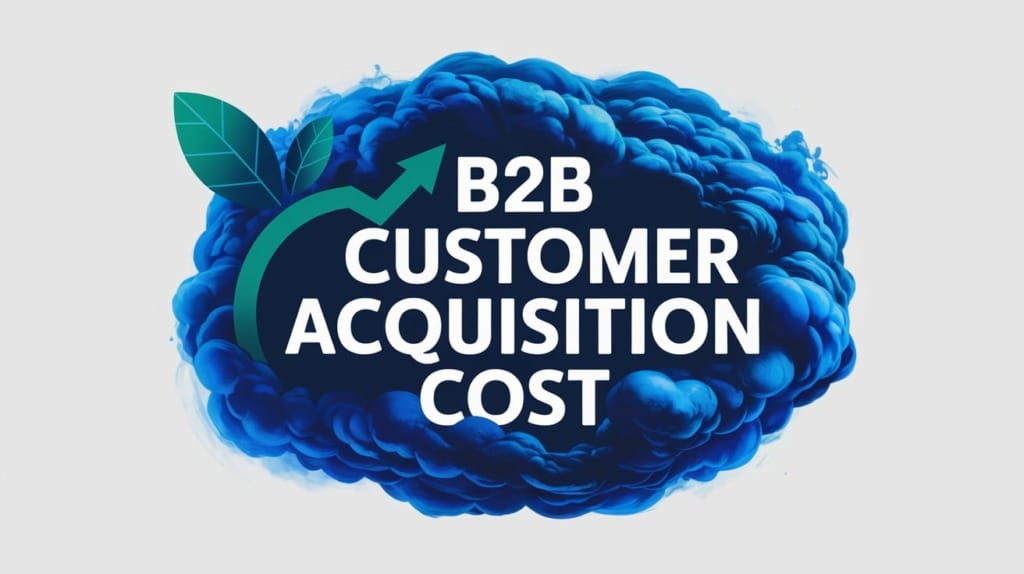
Key Takeaways
Optimizing your customer acquisition cost (CAC) is crucial for profitable, scalable growth. Here are the key takeaways:
- Calculate CAC regularly by dividing total acquisition costs by new customers won. Compare to benchmarks.
- Aim for a CAC that’s significantly lower than customer lifetime value (LTV), such as 1/4 of LTV.
- Improve CAC by optimizing marketing channels, increasing conversion rates, personalizing, and launching referral programs.
- Avoid common CAC mistakes like overspending without ROI tracking, inaccurate LTV, no segmentation, and ignoring retention.
- Leverage organic marketing, focus on customer success, and offer free trials/content to keep CAC low.
- Regularly analyze CAC by channel, segment, campaign, and other cuts to identify optimization opportunities.
- Use CAC alongside metrics like LTV, churn, and CAC payback period to guide investment decisions and strategy.
- Be patient with CAC optimization. It requires continual vigilance rather than one-time fixes.
Mastering CAC best practices will transform your sales and marketing efficiency. Now get out there, crunch some numbers, and start slashing your costs to acquire!
Frequently Asked Questions
Q: What is a good benchmark CAC for my B2B company?
A: CAC benchmarks vary widely by industry. SaaS ranges from $200-$800, IT services $900-$1,500, and consulting $1,000-$2,000. Assess your CAC relative to competitors in your niche.
Q: Should I calculate CAC by channel or campaign?
A: Yes, determining CAC by marketing channel and specific campaigns reveals optimization opportunities. Calculate both overall and channel-specific CACs.
Q: How often should I calculate CAC?
A: Monthly is ideal, but you can also calculate CAC quarterly or annually. The key is to measure it consistently over time.
Q: How do I know if my CAC is too high?
A: Compare your CAC to customer lifetime value (LTV). It should be significantly lower, with a 3:1 or 4:1 LTV to CAC ratio. CAC exceeding LTV means acquisition is unprofitable.
Q: What’s the best way to lower CAC?
A: Start by optimizing marketing channels and campaigns based on ROI. Increase conversion rates by reducing friction. Improve personalization and retention efforts as well.
Q: Can I have a $0 CAC?
A: Extremely unlikely. Even referral programs have associated costs. Focus on continual optimization rather than eliminating spend completely.
Q: Should I lower CAC at all costs?
A: Not necessarily – avoid short term cost-cutting that sacrifices long-term revenue quality. Assess CAC moves holistically.

